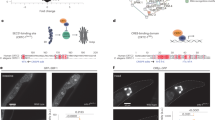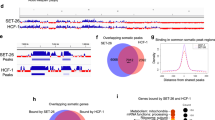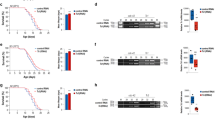Abstract
The plasticity of ageing suggests that longevity may be controlled epigenetically by specific alterations in chromatin state. The link between chromatin and ageing has mostly focused on histone deacetylation by the Sir2 family1,2, but less is known about the role of other histone modifications in longevity. Histone methylation has a crucial role in development and in maintaining stem cell pluripotency in mammals3. Regulators of histone methylation have been associated with ageing in worms4,5,6,7 and flies8, but characterization of their role and mechanism of action has been limited. Here we identify the ASH-2 trithorax complex9, which trimethylates histone H3 at lysine 4 (H3K4), as a regulator of lifespan in Caenorhabditis elegans in a directed RNA interference (RNAi) screen in fertile worms. Deficiencies in members of the ASH-2 complex—ASH-2 itself, WDR-5 and the H3K4 methyltransferase SET-2—extend worm lifespan. Conversely, the H3K4 demethylase RBR-2 is required for normal lifespan, consistent with the idea that an excess of H3K4 trimethylation—a mark associated with active chromatin—is detrimental for longevity. Lifespan extension induced by ASH-2 complex deficiency requires the presence of an intact adult germline and the continuous production of mature eggs. ASH-2 and RBR-2 act in the germline, at least in part, to regulate lifespan and to control a set of genes involved in lifespan determination. These results indicate that the longevity of the soma is regulated by an H3K4 methyltransferase/demethylase complex acting in the C. elegans germline.
This is a preview of subscription content, access via your institution
Access options
Subscribe to this journal
Receive 51 print issues and online access
$199.00 per year
only $3.90 per issue
Buy this article
- Purchase on Springer Link
- Instant access to full article PDF
Prices may be subject to local taxes which are calculated during checkout




Similar content being viewed by others
References
Blander, G. & Guarente, L. The Sir2 family of protein deacetylases. Annu. Rev. Biochem. 73, 417–435 (2004)
Dang, W. et al. Histone H4 lysine 16 acetylation regulates cellular lifespan. Nature 459, 802–807 (2009)
Nottke, A., Colaiacovo, M. P. & Shi, Y. Developmental roles of the histone lysine demethylases. Development 136, 879–889 (2009)
Hamilton, B. et al. A systematic RNAi screen for longevity genes in C. elegans. Genes Dev. 19, 1544–1555 (2005)
Li, J. et al. Caenorhabditis elegans HCF-1 functions in longevity maintenance as a DAF-16 regulator. PLoS Biol. 6, e233 (2008)
McColl, G. et al. Pharmacogenetic analysis of lithium-induced delayed aging in Caenorhabditis elegans. J. Biol. Chem. 283, 350–357 (2008)
Chen, S. et al. The conserved NAD(H)-dependent corepressor CTBP-1 regulates Caenorhabditis elegans life span. Proc. Natl Acad. Sci. USA 106, 1496–1501 (2009)
Siebold, A. P. et al. Polycomb repressive complex 2 and trithorax modulate Drosophila longevity and stress resistance. Proc. Natl Acad. Sci. USA 107, 169–174 (2010)
Wysocka, J., Myers, M. P., Laherty, C. D., Eisenman, R. N. & Herr, W. Human Sin3 deacetylase and trithorax-related Set1/Ash2 histone H3–K4 methyltransferase are tethered together selectively by the cell-proliferation factor HCF-1. Genes Dev. 17, 896–911 (2003)
Lee, S. S. et al. A systematic RNAi screen identifies a critical role for mitochondria in C. elegans longevity. Nature Genet. 33, 40–48 (2003)
Hansen, M., Hsu, A. L., Dillin, A. & Kenyon, C. New genes tied to endocrine, metabolic, and dietary regulation of lifespan from a Caenorhabditis elegans genomic RNAi screen. PLoS Genet. 1, e17 (2005)
Miller, T. et al. COMPASS: a complex of proteins associated with a trithorax-related SET domain protein. Proc. Natl Acad. Sci. USA 98, 12902–12907 (2001)
Papoulas, O. et al. The Drosophila trithorax group proteins BRM, ASH1 and ASH2 are subunits of distinct protein complexes. Development 125, 3955–3966 (1998)
Dou, Y. et al. Regulation of MLL1 H3K4 methyltransferase activity by its core components. Nature Struct. Mol. Biol. 13, 713–719 (2006)
Wysocka, J. et al. WDR5 associates with histone H3 methylated at K4 and is essential for H3 K4 methylation and vertebrate development. Cell 121, 859–872 (2005)
Simonet, T., Dulermo, R., Schott, S. & Palladino, F. Antagonistic functions of SET-2/SET1 and HPL/HP1 proteins in C. elegans development. Dev. Biol. 312, 367–383 (2007)
Ruthenburg, A. J., Allis, C. D. & Wysocka, J. Methylation of lysine 4 on histone H3: intricacy of writing and reading a single epigenetic mark. Mol. Cell 25, 15–30 (2007)
Schneider, J. et al. Molecular regulation of histone H3 trimethylation by COMPASS and the regulation of gene expression. Mol. Cell 19, 849–856 (2005)
Christensen, J. et al. RBP2 belongs to a family of demethylases, specific for tri-and dimethylated lysine 4 on histone 3. Cell 128, 1063–1076 (2007)
Xu, L. & Strome, S. Depletion of a novel SET-domain protein enhances the sterility of mes-3 and mes-4 mutants of Caenorhabditis elegans. Genetics 159, 1019–1029 (2001)
Arantes-Oliveira, N., Apfeld, J., Dillin, A. & Kenyon, C. Regulation of life-span by germ-line stem cells in Caenorhabditis elegans. Science 295, 502–505 (2002)
Berman, J. R. & Kenyon, C. Germ-cell loss extends C. elegans life span through regulation of DAF-16 by kri-1 and lipophilic-hormone signaling. Cell 124, 1055–1068 (2006)
Budovskaya, Y. V. et al. An elt-3/elt-5/elt-6 GATA transcription circuit guides aging in C. elegans. Cell 134, 291–303 (2008)
Sijen, T. et al. On the role of RNA amplification in dsRNA-triggered gene silencing. Cell 107, 465–476 (2001)
Kelly, W. G., Xu, S., Montgomery, M. K. & Fire, A. Distinct requirements for somatic and germline expression of a generally expressed Caenorhabditis elegans gene. Genetics 146, 227–238 (1997)
Mitchell, D. H., Stiles, J. W., Santelli, J. & Sanadi, D. R. Synchronous growth and aging of Caenorhabditis elegans in the presence of fluorodeoxyuridine. J. Gerontol. 34, 28–36 (1979)
Lee, S. S., Kennedy, S., Tolonen, A. C. & Ruvkun, G. DAF-16 target genes that control C. elegans life-span and metabolism. Science 300, 644–647 (2003)
Haag, E. S., Wang, S. & Kimble, J. Rapid coevolution of the nematode sex-determining genes fem-3 and tra-2. Curr. Biol. 12, 2035–2041 (2002)
Gerisch, B., Weitzel, C., Kober-Eisermann, C., Rottiers, V. & Antebi, A. A hormonal signaling pathway influencing C. elegans metabolism, reproductive development, and life span. Dev. Cell 1, 841–851 (2001)
Greer, E. L. et al. An AMPK-FOXO pathway mediates longevity induced by a novel method of dietary restriction in C. elegans. Curr. Biol. 17, 1646–1656 (2007)
Mello, C. C. et al. The PIE-1 protein and germline specification in C. elegans embryos. Nature 382, 710–712 (1996)
Fire, A., Harrison, S. W. & Dixon, D. A modular set of lacZ fusion vectors for studying gene expression in Caenorhabditis elegans. Gene 93, 189–190 (1990)
Cheeseman, I. M. et al. A conserved protein network controls assembly of the outer kinetochore and its ability to sustain tension. Genes Dev. 18, 2255–2268 (2004)
Venteicher, A. S., Meng, Z., Mason, P. J., Veenstra, T. D. & Artandi, S. E. Identification of ATPases pontin and reptin as telomerase components essential for holoenzyme assembly. Cell 132, 945–957 (2008)
Klassen, M. P. & Shen, K. Wnt signaling positions neuromuscular connectivity by inhibiting synapse formation in C. elegans. Cell 130, 704–716 (2007)
Praitis, V., Casey, E., Collar, D. & Austin, J. Creation of low-copy integrated transgenic lines in Caenorhabditis elegans. Genetics 157, 1217–1226 (2001)
Merritt, C. & Seydoux, G. In WormBook (ed. The C. elegans Research Community). 10.1895/wormbook.1.148.1 〈http://www.wormbook.org/〉 (2010)
Tusher, V. G., Tibshirani, R. & Chu, G. Significance analysis of microarrays applied to the ionizing radiation response. Proc. Natl Acad. Sci. USA 98, 5116–5121 (2001)
Eisen, M. B., Spellman, P. T., Brown, P. O. & Botstein, D. Cluster analysis and display of genome-wide expression patterns. Proc. Natl Acad. Sci. USA 95, 14863–14868 (1998)
Saldanha, A. J. Java Treeview–extensible visualization of microarray data. Bioinformatics 20, 3246–3248 (2004)
Beissbarth, T. & Speed, T. P. GOstat: find statistically overrepresented Gene Ontologies within a group of genes. Bioinformatics 20, 1464–1465 (2004)
Shi, X. et al. Modulation of p53 function by SET8-mediated methylation at lysine 382. Mol. Cell 27, 636–646 (2007)
Acknowledgements
We are grateful to A. Fire, K. Helin, S. Kim, K. Shen, T. Stiernagle and the Caenorhabditis Genetics Center, M. W. Tan and A. Villeneuve for gifts of strains, reagents and antibodies. We thank S. Kim, G. Seydoux, C. Slightam and K. Shen for advice on worm transgenesis, and S. Kim, A. Morgan and Y. Kobayashi for help with microarray analysis. We thank A. Fire, S. Kim, G. Seydoux, M. W. Tan and J. Wysocka for discussions. We thank members of the Brunet laboratory, M. Kaeberlein, J. Lieberman, J. Sage and J. Wysocka for critical reading of the manuscript. This work was supported by NIH grant R01-AG31198 to A.B.; E.L.G. was supported by NIH training grant T32-CA009302, an NSF graduate fellowship and by NIH ARRA-AG31198. T.J.M. was supported by NIH grant T32-HG000044. D.S.L. and E.M.G. were supported by NIH training grant T32-CA009302. S.H. was supported by a Stanford graduate fellowship. G.S.M. was supported by a Human Frontier Science Program post-doctoral fellowship. M.R.B. was supported by NIH fellowship F31-AG032837. O.G. was supported by a Searle Scholar award.
Author information
Authors and Affiliations
Contributions
E.L.G. and A.B. conceived and planned the study. E.L.G. performed the experiments and wrote the paper with the help of A.B.; T.J.M. completed Fig. 3a, b, Supplementary Fig. 4c, e and Supplementary Fig. 8c, and generated all low-copy integrant transgenic worm lines. A.G.H. helped with Fig. 1b, e and Supplementary Fig. 1f. E.M.G. was advised by O.G. and completed Fig. 1f and Supplementary Fig. 1g. D.S.L. helped with Fig. 2a. G.S.M. generated all high-copy transgenic worm lines. S.H. helped with Supplementary Fig. 8c. M.R.B. generated the Prbr-2::rbr-2::gfp construct. All authors discussed the results and commented on the manuscript.
Corresponding author
Ethics declarations
Competing interests
The authors declare no competing financial interests.
Supplementary information
Supplementary Information
This file contains Supplementary Figures 1-10 with legends and Supplementary Tables 1-5. (PDF 17564 kb)
Supplementary Table 6
This table shows the normalized and log-transformed microarray gene expression values in WT(N2) and glp-1(e2141ts) mutant worms treated with empty vector (E.V.) vs ash-2 RNAi at day 2 of life (larval stage L3). (XLS 6370 kb)
Supplementary Table 7
This table shows the normalized and log-transformed microarray gene expression values in WT(N2) and glp-1(e2141ts) mutant worms treated with empty vector (E.V.) vs ash-2 RNAi at day 8 of life (day 5 of adulthood). (XLS 5970 kb)
Supplementary Table 8
This table shows the normalized microarray gene expression values at day 2 of life (larval stage L3) corresponding to the cluster in Figure 3e (left panel). (XLS 45 kb)
Supplementary Table 9
This table shows the normalized microarray gene expression values at day 8 of life (day 5 of adulthood) corresponding to the cluster in Figure 3e (right panel). (XLS 102 kb)
Rights and permissions
About this article
Cite this article
Greer, E., Maures, T., Hauswirth, A. et al. Members of the H3K4 trimethylation complex regulate lifespan in a germline-dependent manner in C. elegans. Nature 466, 383–387 (2010). https://doi.org/10.1038/nature09195
Received:
Accepted:
Published:
Issue Date:
DOI: https://doi.org/10.1038/nature09195
This article is cited by
-
Early life changes in histone landscape protect against age-associated amyloid toxicities through HSF-1-dependent regulation of lipid metabolism
Nature Aging (2023)
-
Pregnane X receptor agonist nomilin extends lifespan and healthspan in preclinical models through detoxification functions
Nature Communications (2023)
-
Lipid droplets and peroxisomes are co-regulated to drive lifespan extension in response to mono-unsaturated fatty acids
Nature Cell Biology (2023)
-
Methylation across the central dogma in health and diseases: new therapeutic strategies
Signal Transduction and Targeted Therapy (2023)
-
The CRTC-1 transcriptional domain is required for COMPASS complex-mediated longevity in C. elegans
Nature Aging (2023)
Comments
By submitting a comment you agree to abide by our Terms and Community Guidelines. If you find something abusive or that does not comply with our terms or guidelines please flag it as inappropriate.



